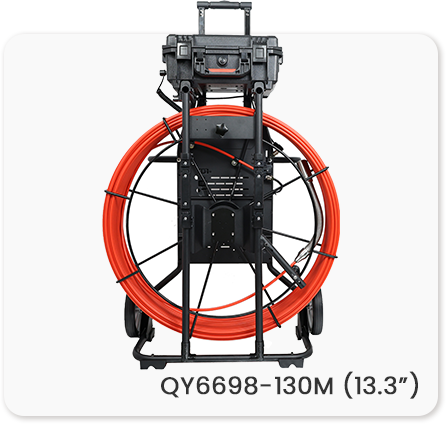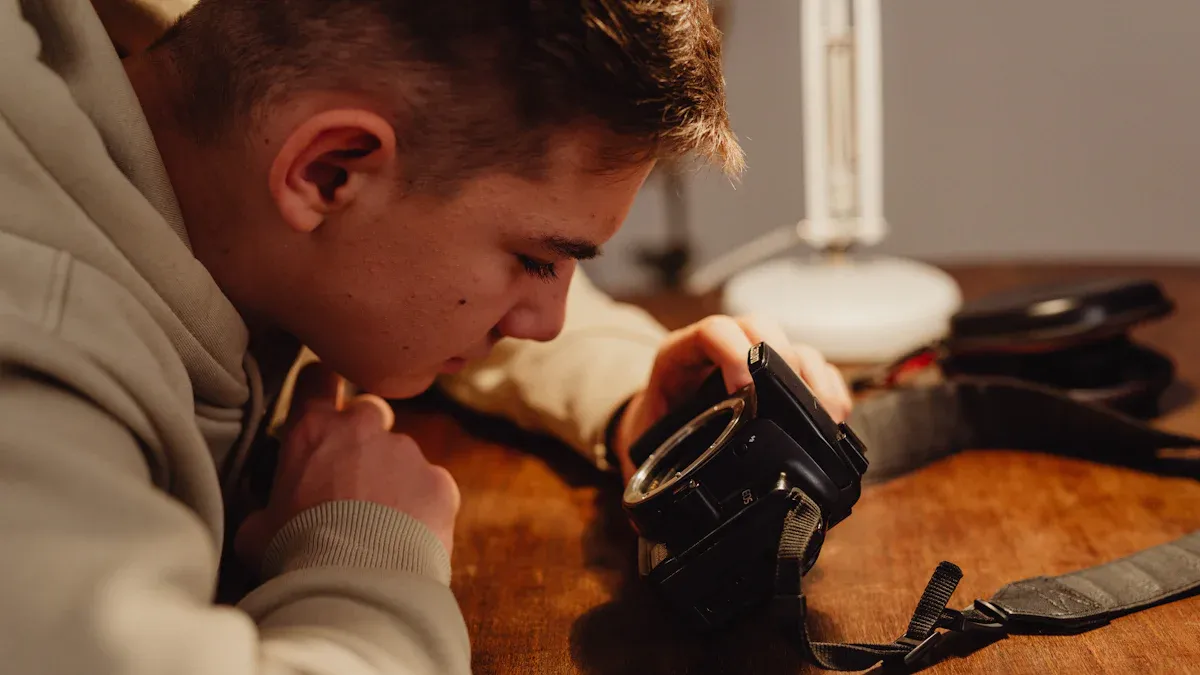Views: 0 Author: Site Editor Publish Time: 2025-08-06 Origin: Site









If you want to use inspection camera tools well, first turn it on and check if the lights work. Move the camera slowly and look at the screen for problems. Good lighting helps you see cracks, leaks, or things blocking pipes or small spaces. You can use inspection camera devices for plumbing, electrical jobs, or looking into crawlspaces at home or work. Many people like a QYTeco sewer inspection camera because it makes hard jobs easier and shows clear results.
Always get your inspection camera and work area ready before you start. This helps you see clearly and stay safe. Move the camera slowly and look at the screen closely. This helps you find cracks, leaks, or blockages without breaking anything. Use good lighting and the camera’s features like zoom and recording. This helps you get clear pictures and save important records. Follow safety rules by wearing protective gear and being gentle with the camera. This keeps you and the camera safe. Pick good tools like QYTeco cameras. They give strong support, easy upgrades, and last a long time.

An inspection camera lets you see inside places your eyes cannot reach. People also call it a drain camera, plumbing camera, or sewer inspection camera. This tool has a small camera on a bendy or stiff tube. The camera sends live video or pictures to a screen. You can find problems without taking things apart. Many models have bright LED lights to help you see in dark spots. Some cameras let you record what you see or use features like zoom or wireless controls.
Inspection cameras work for many jobs at home or work. Here are some ways people use these cameras:
Industry | Primary Uses of Inspection Cameras |
|---|---|
Oil and Gas | Check pipelines, tanks, and refineries. Spot leaks. Do remote inspections in risky areas. |
Automotive and Aerospace | Inspect vehicles, engines, transmissions, and welds. Use automotive borescopes for tight spaces. |
Construction and Building | Look at walls, roofs, and wiring. Use a drain inspection camera for plumbing and drains. |
Municipal Utilities & Water/Wastewater | Use a sewer inspection camera for sewer lines and water pipes. Manage assets and plan repairs. |
Manufacturing and Maintenance | Inspect machines, welds, and production lines. Use a borescope inspection camera for easy checks. |
You can use a drain camera to find clogs. A plumbing camera helps you check for leaks. A sewer inspection camera helps you look for cracks in pipes. Automotive borescopes help you see inside engines without taking them apart.
Tip: Inspection cameras help you save time and money. You do not need to break walls or dig up pipes to find problems.
A borescope is a tool with a long, thin tube. It lets you look inside machines or tight spaces. You use a borescope for simple checks, like looking inside an engine or pipe. A borescope inspection camera, or video borescope, does even more. It has a tiny digital camera at the tip. It sends live video to a screen or your phone.
A borescope can be stiff or bendy. It usually shows images through an eyepiece.
A borescope inspection camera uses a digital camera and LED lights for clear images.
You can see live video, zoom in, and record what you find.
Some borescope inspection cameras send images wirelessly. You can share them right away.
Automotive borescopes and drain inspection camera models help you check engines, pipes, and drains.
In vehicle inspection, a borescope inspection camera helps you spot damage or wear.
A sewer inspection camera or drain camera with a borescope inspection camera design helps you find blockages or cracks deep in pipes.
Many industries use borescope inspection camera tools for safe and fast checks.
You can use a borescope inspection camera for plumbing, building, or aircraft checks.
The main difference is that a borescope inspection camera gives you better images, more features, and makes your job easier.

Learning how to use a sewer inspection camera can make tough jobs much easier. You get a clear look inside pipes, drains, and tight spaces without tearing things apart. Let’s walk through each step so you can use inspection camera tools like a pro.
Before beginning the inspection, you need to get your equipment ready. Here’s a simple checklist:
Clean the pipe or drain first. Use water jets or cleaning tools to remove sludge and debris. This helps you see clearly when you use inspection camera devices.
Check your sewer inspection camera for damage. Look at the lens, cables, and lights. Make sure the battery is charged and the memory card is in place.
Power on the camera. Test the built-in LED lights. Adjust the brightness if needed.
Read the user manual. Every plumbing camera or borescope inspection camera has its own features.
Gather your safety gear and tools. You might need gloves, safety glasses, and disinfectant wipes.
Make sure you have the right borescope or drain inspection camera for the job. Some pipes need a flexible borescope, while others need a stiffer probe.
Tip: Always check your equipment before you start. This helps you avoid interruptions and keeps your sewer camera working longer.
Safety comes first when you use inspection camera tools. Here are some important rules:
Wear gloves, safety glasses, and protective clothing. Pipes can have sharp edges or hazardous materials.
Only use the sewer inspection camera for observation. Never try to push through clogs or use it as a cleaning tool.
Move slowly and avoid using force when inserting the probe. This protects both the camera and the pipe.
Stay close to the drain opening. Keep your hand near the entry point to prevent kinks or bends in the cable.
Don’t operate the camera in extreme heat or cold. Store it in a dry, safe place after use.
Follow all safety guidelines from the manufacturer. If you’re new to this, get proper training or ask for help.
Watch for warning messages on the screen. Stop if you see anything unusual.
Note: Never use a borescope inspection camera for medical purposes or in places it’s not designed for.
Setting up the inspection area helps you get the best results. Here’s what you should do:
Clean the entry point, like a drain or cleanout, before inserting the probe.
Remove any covers or grates that block the way.
Make sure the area is well-lit and safe to work in.
Keep your tools and cleaning supplies nearby.
If you’re investigating the drain in a busy area, set up barriers or warning signs.
A clean and organized area makes it easier to use inspection camera tools and helps you avoid mistakes.
Now you’re ready to insert the camera. Here’s how to do it right:
Hold the borescope inspection camera or drain camera near the entry point.
Insert the probe gently. Never use force. If you feel resistance, stop and check for blockages.
Feed the cable slowly and keep your hand close to the opening.
Avoid bending or twisting the tube. This keeps the fiber optics and cables safe.
Watch the screen as you go. Look for signs of clogs, cracks, or other problems.
Tip: Move the camera slowly. Fast motions can blur the image or damage the lens.
Once the camera is inside, you can start your detailed visual inspection. Here’s how to get the most out of your sewer inspection camera:
Use the built-in LED lights to brighten dark spots. Adjust the brightness for clear images.
Move the camera slowly and steadily. This helps you spot small cracks or leaks.
Use the on-screen distance counter to track how far you’ve gone.
If your borescope inspection camera has zoom or swivel features, use them to look around bends or tight spaces.
Take notes or mark spots where you see problems. This helps with finding obstructions in a pipe or finding damaged plumbing later.
Some cameras have extra tools like locators or pipe skids. These help you move through tricky areas and keep the camera steady.
Good documentation is key when you use inspection camera tools. Here’s how to record your findings:
Feature | How It Helps You |
|---|---|
Video recording | Save videos and images for later review or sharing. |
Memory/storage | Store data on SD cards for easy transfer and reporting. |
Built-in LED illumination | Make sure you don’t miss anything in dark pipes. |
Ergonomic controls | Use one hand to operate the camera and take notes. |
Cable flexibility | Reach deep into pipes with flexible cables. |
Thermal imaging overlay | Some borescope inspection camera models show heat differences for better analysis. |
Monitor/display | View results clearly on a bright LCD screen. |
Many borescope inspection camera tools let you take screenshots or record video. Some even have 360° cameras for a full view. Always label your files with the date, location, and any notes about what you found.
When you finish, it’s time to remove the camera safely:
Pull the camera out slowly and gently. Don’t bend or twist the tube.
Keep your hand near the entry point to guide the cable.
Wipe the camera lens and probe with a soft cloth and isopropyl alcohol.
Check the camera and cables for any damage.
Store the camera in its case with the cable fully inside.
Note: Never use harsh chemicals or abrasive materials on the lens. This can cause permanent damage.
After you use inspection camera tools, take a few minutes to clean up and review your work:
Power off the sewer inspection camera before cleaning.
Wipe down the lens, probe, and any other parts with a soft, dry cloth.
Use isopropyl alcohol for the lens and tip glass.
Inspect cables and connectors for wear or damage.
Store everything in a dry, safe place away from heat and sunlight.
Review your recorded videos and notes. Make a report if needed.
Taking care of your borescope, plumbing camera, or drain inspection camera keeps it working well for the next job. Regular cleaning and careful storage help you avoid costly repairs.
Tip: Patience and thoroughness matter. Move slowly, check your work, and always follow best practices for how to use a sewer inspection camera.
QYTeco is a top choice for a sewer inspection camera. This company is known for making good inspection cameras and drain cleaning tools. Their products work well for home or work jobs. QYTeco makes each sewer inspection camera comfortable to hold. The handles fit your hand, so you can use them for a long time without getting tired. Even if you are new, QYTeco borescope tools are simple to use.
QYTeco lets you change parts or upgrade your borescope. You do not need to buy a new camera for new features. This helps you save money. QYTeco borescopes are strong and last many years. They also give you lifetime maintenance, so your sewer inspection camera stays in good shape.
Tip: QYTeco is a smart pick if you want a borescope that can change as your needs grow.
QYTeco puts many helpful features in every borescope. The bright LED lights help you see in dark pipes. The camera shows clear images, so you can find cracks or clogs quickly. Some models let you record video or take pictures right away. You can use the borescope in small spaces, around corners, or even underwater if the model allows.
Here are some features you might get:
Probes that are flexible or stiff for different jobs
Screens with high resolution for easy viewing
Long cables to reach far into pipes
Waterproof designs for tough jobs
Simple controls that work even with gloves
QYTeco can also make special borescopes just for you. If you need something different, you can ask QYTeco to design it. Their team works with you to make sure your sewer inspection camera is just right.
QYTeco gives you great customer support. Their team answers your questions and helps you fix problems fast. If your borescope breaks, QYTeco will repair it for life. You can call or email them any time you need help. They also have guides and videos to show you how to use your sewer inspection camera.
Note: QYTeco’s support helps you get the best use from your borescope, no matter how much you know.
You can get great results with an inspection camera when you follow a few simple steps. Start by picking the right camera, check your lighting, and move slowly as you inspect. QYTeco makes this process even easier with reliable tools and strong support. For the best results, try these expert tips:
Set clear goals before you start.
Test your approach with a small project.
Use good lighting for clear images.
Learn how to use your camera well.
Keep good notes and records.
Review your findings to improve next time.
Talk with your team to share ideas.
When you follow these steps, you make every inspection safer and more effective!
First, turn on the camera and check if the lights work. Put the camera into the engine or under the car. Look at the screen to find any problems. You can see inside small spaces without taking things apart. This makes vehicle inspection much easier.
Yes, automotive borescopes let you look deep inside engines. You can find hidden problems like cracks or leaks. Move the camera into the engine and watch the live video. Look for anything that looks strange.
Automotive borescopes have long, bendy probes. They can reach tight spots in cars or trucks. Regular cameras cannot do this job. These tools help you check engines and other hard-to-reach places.
No, you do not need special training. Most inspection cameras are easy to use. You can read the manual and start right away. Practice will help you get better at using it.
Clean the lens and cable after every use. Store the camera in a dry place. Check for damage before each job. Taking care of your automotive borescopes keeps them ready for the next inspection.